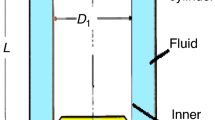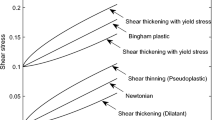Abstract
Some physicochemical properties of water fluids (WFs) that underlie their applications and criteria for determining the parameter domains with qualitative differences in their physical state were considered. The qualitative relationship between the type and intensity of intermolecular interactions in various substances and their macroscopic characteristics (normal boiling temperatures and critical points) was analyzed. Special attention was paid to the density as a macroscopic parameter that reflects the influence of intermolecular interactions in the WF. Despite the technological importance of isobaric dependences, for understanding the mechanisms of various effects on the properties of fluids, it is necessary to consider isochoric and isothermal dependences, especially when analyzing the dielectric properties of water and its dissociation into counterions.







Similar content being viewed by others
REFERENCES
V. N. Ipat’ev, Catalytic Reactions at High Temperatures and Pressures: 1900–1933 (Akad. Nauk SSSR, Moscow, 1936) [in Russian].
I. R. Krichevskii and Ya. S. Kazarnovskii, Zh. Fiz. Khim. 13, 378 (1939).
I. R. Krichevskii and D. Yu. Gamburg, Zh. Fiz. Khim. 17, 215 (1943).
I. R. Krichevskii, Phase Equilibria in Solutions at High Pressures (Goskhimizdat, Moscow, 1946) [in Russian].
I. R. Krichevskii, Thermodynamics of Critical Infinitely Dilute Solutions (Khimiya, Moscow, 1975) [in Russian].
M. Temkin and V. Pyzhev, Zh. Fiz. Khim. 13, 851 (1939).
M. Temkin, Zh. Fiz. Khim. 17, 269 (1943).
M. Temkin, Zh. Fiz. Khim. 17, 414 (1943).
D. S. Tsiklis, Layering of Gas Mixtures (Khimiya, Moscow, 1969) [in Russian].
D. S. Tsiklis, Technique of Physicochemical Research at High and Superhigh Pressures, 4th ed. (Khimiya, Moscow, 1976) [in Russian].
M. G. Gonikberg, Chemical Equilibrium and Reaction Rate at High Pressures, 2nd ed. (Akad. Nauk SSSR, Moscow, 1960) [in Russian].
L. P. Filippov, Similarity of Properties of Substances (Mosk. Gos. Univ., Moscow, 1978) [in Russian].
L. P. Filippov, Prediction of Thermophysical Properties of Liquids and Gases (Energoatomizdat, Moscow, 1988) [in Russian].
N. B. Vargaftic, Handbook of Thermophysical Properties of Gases and Liquids (Nauka, Moscow, 1972) [in Russian].
Reference Book of Nitrogenman, Ed. by E. Ya. Mel’nikov (Khimiya, Moscow, 1986) [in Russian].
E. Kiran and J. M. H. Levelt Sengers, in Supercritical Fluids. Fundamentals for Application, Ed. by E. Kiran and J. M. H. Levelt Sengers, Vol. 273 of NATO Science Ser. E: Applied Science (Springer Science, New York, 1994), p. IX.
Supercritical Fluids. Fundamentals for Application, Ed. by E. Kiran and J. M. H. Levelt Sengers, Vol. 273 of NATO Science, Ser. E: Applied Science (Springer Science, New York, 1994).
Sverkhkrit. Fluidy Teor. Prakt. 15 (1), 3 (2020).
A. A. Galkin and V. V. Lunin, Russ. Chem. Rev. 74, 21 (2005).
M. N. Danchevskaya, Y. D. Ivakin, S. N. Torbin, et al., J. Mater. Sci. 41, 1385 (2006).
M. N. Danchevskaya, Y. D. Ivakin, S. N. Torbin, and G. P. Muravieva, J. Supercrit. Fluids 46, 358 (2008).
M. Yu. Sinev, Yu. D. Ivakin, D. P. Shashkin, et al., Sverkhkrit. Fluidy: Teor. Prakt. 14 (3), 45 (2019).
A. A. Maerle, I. A. Kasyanov, I. F. Moskovskaya, and B. V. Romanovsky, Russ. J. Phys. Chem. A 90, 1212 (2016).
I. I. Ivanova, Y. G. Kolyagin, I. A. Kasyanov, et al., Angew. Chem. Int. Ed. 56, 15344 (2017).
A. V. Shkuropatov, E. E. Knyazeva, O. A. Ponomareva, and I. I. Ivanova, Neftekhimiya 58, 529 (2018).
G. Brunner, Hydrothermal and Supercritical Water Processes. Supercritical Fluid Science and Technology, Vol. 5 of Elsevier Book Series (Elsevier, Amsterdam, 2014).
Near-Critical and Supercritical Water and Their Applications for Biorefineries, Ed. by Zh. Fang and Ch. Xu (Springer Science, Dordrecht, 2014).
M. Yu. Sinev and O. V. Shapovalova, Sverkhkrit. Fluidy: Teor. Prakt. 15 (3) (2020, in press).
NIST Chemistry WebBook, NIST Standard Reference Database Number 69 (2018). https://webbook.nist.gov/chemistry/. https://doi.org/10.18434/T4D303
E. A. Lagunova, Yu. D. Ivakin, M. Yu. Sinev, et al., Sverkhkrit. Fluidy: Teor. Prakt. 14 (4), 49 (2019).
D. A. Tolstunov and L. P. Filippov, Zh. Fiz. Khim. 56, 129 (1982).
A. D. Okhotsimskii and L. P. Filippov, Sov. Phys. Dokl. 30, 100 (1985).
J. E. Jones, Proc. R. Soc. London, Ser. A 106, 463 (1924).
J. L. F. Abascal and C. Vega, J. Chem. Phys. 123, 234505 (2005).
G. A. Cisneros, K. T. Wikfeldt, L. Ojamäe, et al., Chem. Rev. 116, 7501 (2016).
The Chemist’s Reference Book (Goskhimizdat, Moscow, Leningrad, 1963), Vol. 1 [in Russian].
M. Kh. Karapet’yants and M. L. Karapet’yants, Principle Thermodynamic Constants of Inorganic and Organic Substances (Khimiya, Moscow, 1968) [in Russian].
Short Handbook of Physicochemical Values, Ed. by K. P. Mishchenko and A. A. Ravdel’, 7th ed. (Khimiya, Leningrad, 1974) [in Russian].
Properties of Inorganic Compounds, The Handbook, Ed. by V. A. Rabinovich (Khimiya, Leningrad, 1983) [in Russian].
I. B. Rabinovich, Isotope Substitution Effects on the Physicochemical Properties of Liquids (Nauka, Moscow, 1968) [in Russian].
M. Yu. Sinev, Yu. A. Gordienko, E. A. Ponomareva, and Yu. D. Ivakin, Sverkhkrit. Fluidy: Teor. Prakt. 14 (2), 116 (2019).
M. V. Avdeev, V. N. Bagratashvili, A. N. Konovalov, et al., Sverkhkrit. Fluidy: Teor. Prakt. 2 (1), 28 (2007).
W. L. Marshall and E. U. Franck, J. Phys. Chem. Ref. Data 10, 295 (1981).
D. P. Fernandez, A. R. H. Goodwin, E. W. Lemmon, et al., J. Phys. Chem. Ref. Data 26, 1125 (1997).
I. M. Abdulagatov and P. V. Skripov, Sverkhkrit. Fluidy: Teor. Prakt. 15 (1), 34 (2020).
Yu. E. Gorbatyi, Doctoral (Phys. Math.) Dissertation (Inst. Chem. Phys. Acad. Sci. USSR, Moscow, 1988).
E. A. Lagunova, Yu. D. Ivakin, M. Yu. Sinev, et al., Sverkhkrit. Fluidy: Teor. Prakt. 14 (4), 49 (2019).
ACKNOWLEDGMENTS
With deep gratitude I keep memory of the years when I had good fortune to communicate with Academician Lunin and work with him both on various projects in the “supercritical” community and in the editorial boards of the journals headed by Valery Vasil’evich. With gratitude and sorrow I also recall my first superior and close acquaintance who also recently passed away—Aleksandr Zakharovich Shabutov, with whom I studied a complex problem, namely, the solubility of chlorine and hydrogen chloride in various media and worked on apparatus design and high-pressure experimental techniques.
Funding
This study was financially supported by the Russian Foundation for Basic Research (project no. 18-29-06055).
Author information
Authors and Affiliations
Corresponding author
Additional information
Translated by L. Smolina
Rights and permissions
About this article
Cite this article
Sinev, M.Y. Physical Chemistry of Water Fluids As a Basis for Technological Processes with Their Participation. Russ. J. Phys. Chem. 95, 418–428 (2021). https://doi.org/10.1134/S0036024421030195
Received:
Revised:
Accepted:
Published:
Issue Date:
DOI: https://doi.org/10.1134/S0036024421030195




